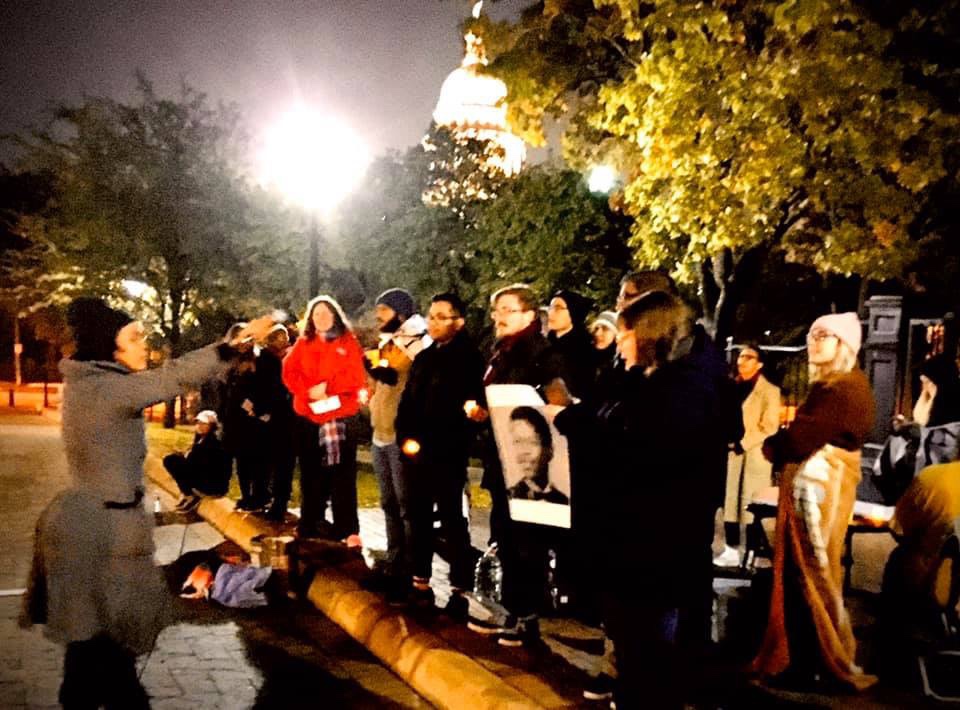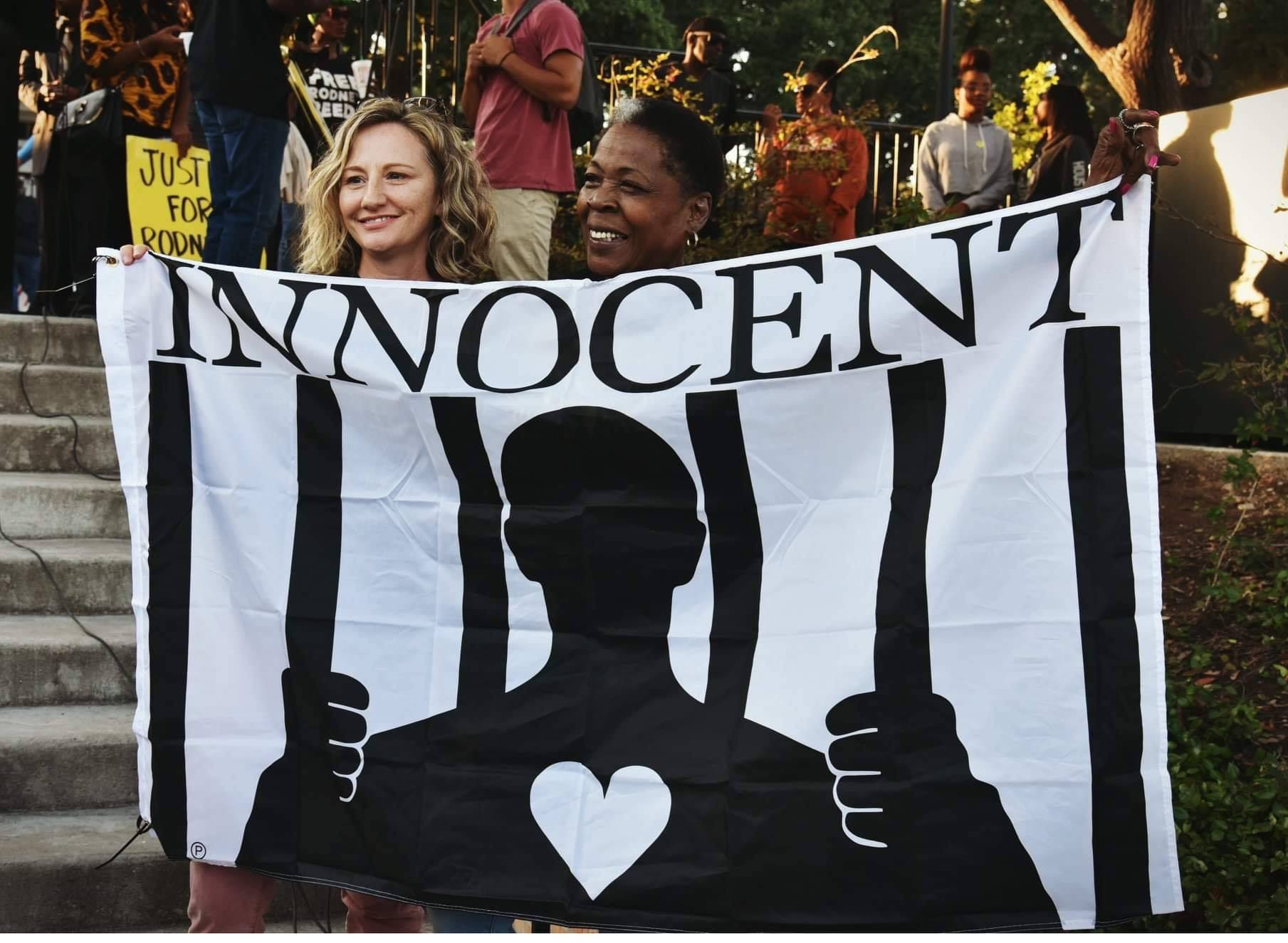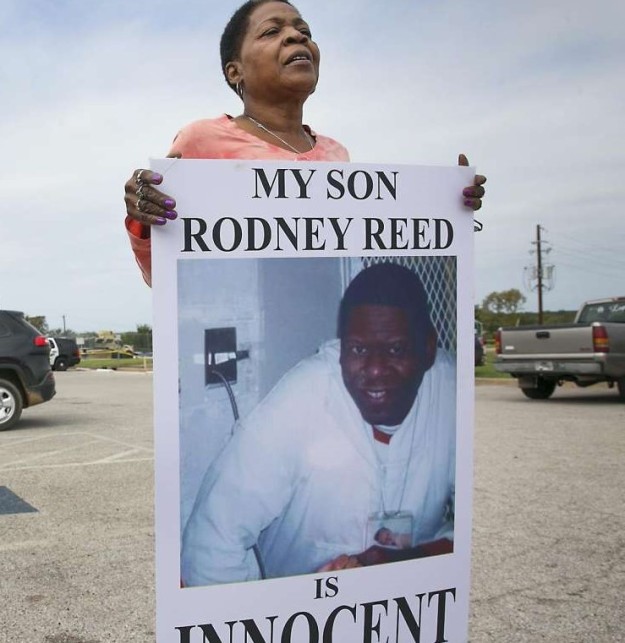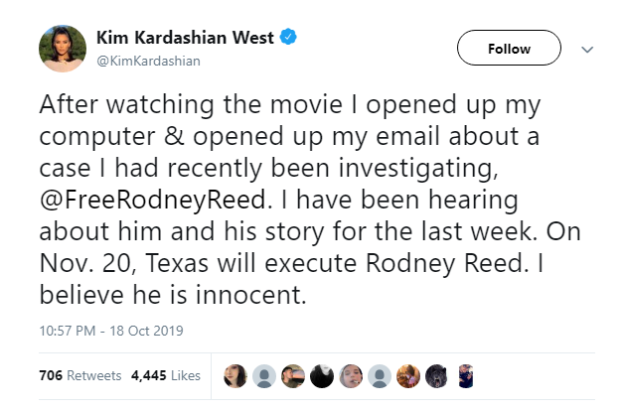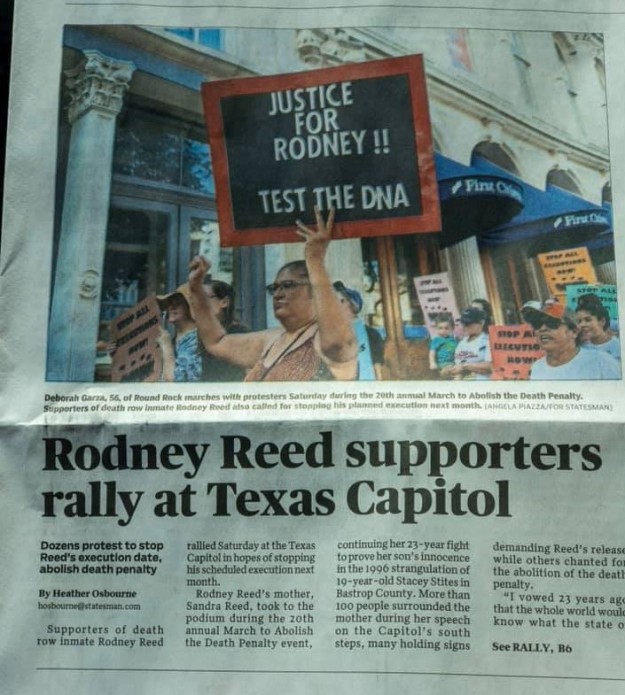November 8, 2019
Jordan Smith has been writing about the case of Rodney Reed for 18 years. Below is her latest piece for the Intercept. Read, share, and please join us on Saturday to demand justice for Rodney Reed.
DEKE PIERCE WAS wearing civilian clothes as he took to the lectern in a narrow press room inside the Texas Capitol in Austin last month, but it was still obvious that he was a cop. He stood with his feet wide and his arms slightly away from his body, a stance molded by years in a uniform encumbered by heavy gear. He was there to make an extraordinary announcement: He and 12 other members of law enforcement with more than 250 years of combined experience had filed a friend-of-the-court brief with the U.S. Supreme Court in favor of a Texas death row prisoner named Rodney Reed, slated for execution on November 20.
“We each care deeply about the criminal justice system and the rule of law. While that often means holding wrongdoers accountable, it is the equally important goal of the criminal justice system to avoid punishing the innocent,” Pierce told a group of reporters. “Not only would moving forward with Mr. Reed’s execution be cruel and immoral, it would also undermine the rule of law and the legitimacy of the very system we as law enforcement officers swore to uphold.”
Their brief argues that Reed’s conviction was tainted by common problems in law enforcement — forensic errors, “weak facts,” tunnel vision, and “community pressure that can distort an investigation.” The officers argue that in this case there is “uniquely compelling” evidence that Reed is innocent.
Pierce and his fellow officers join an increasing number of high-profile voices calling for a stay of execution and a thorough review of Reed’s case as a stream of new witnesses continue to come forward with revelations that cast doubt on Reed’s conviction; there is one who now says another suspect confessed to the crime that put Reed on death row. Reed’s lawyers, including his long-time attorney Bryce Benjet of the Innocence Project, have asked various courts to intervene, among them the U.S. Supreme Court. Those actions remain pending as the clock ticks down toward the execution date.
While Pierce and his colleagues understand “as well as anyone the need for finality in criminal cases,” they wrote, where “there is a significant risk of executing an innocent man, that need for finality must yield to the needs of justice.”
18 Years on the Case
Rodney Reed was convicted and sentenced to die in 1998 for the rape and murder of 19-year-old Stacey Stites two years earlier. On April 23, 1996, Stites was found dead, her body dumped on the side of a country road outside of Bastrop, a small town roughly a half-hour east of Austin. She was partially clothed and lying face up, her arms above her head. Marks on her neck led investigators to conclude that she’d been strangled with a length of braided leather belt, a piece of which was left nearby. Sperm was collected from inside her.
The murder went unsolved for nearly a year before law enforcement officers, apparently acting on a hunch, tested the recovered DNA against 29-year-old Reed. It matched and formed the basis of the prosecution’s case. No other evidence tied Reed to the murder. The DNA was the “Cinderella’s slipper,” prosecutors argued at trial.
When he was initially questioned by police, Reed denied knowing Stites, but soon admitted to having an affair with her, which would explain the presence of his DNA; the two had sex just days before Stites was found dead, he said.
It’s hardly surprising that Reed wasn’t immediately forthcoming. The relationship would have been a risky one in small-town Texas, even in the mid-1990s: Reed is black, and Stites was white and engaged to a man named Jimmy Fennell, a white cop in a neighboring town.
At trial, Reed had various witnesses lined up who could testify to the relationship, but most weren’t called, seemingly because they were related to Reed. Those who did testify weren’t particularly effective: One woman referred to Stites as “Stephanie” when recounting meeting her at the Reed family’s Bastrop home. Among the witnesses who weren’t called were at least two who said they knew about the affair and that Fennell had found out about it and threatened Reed.
Over the last 18 years, I’ve written dozens of times about Reed’s case. It was clear early on that it had serious problems and that Reed’s conviction left open a number of questions about what happened to Stites and why. As the years have passed, the case has become even more disturbing. There is medical and forensic evidence that has been debunked. There are witnesses — including within Stites’s family — who have come forward to say they were aware of the relationship. And then there’s Fennell. There’s been a lot of troubling information about him, too, including from law enforcement officers disturbed by his behavior both before and after Stites’s murder. Some of that information should have been made available to defense lawyers before Reed’s trial but wasn’t.
And then there are the courts, crucially including Texas’s Court of Criminal Appeals, which has repeatedly demonstrated a results-oriented willful ignorance in the face of mounting evidence challenging the conviction.
A Suspicious Timeline
From the beginning, the state’s theory of Stites’s murder was a problem. On the day she died, Stites was slated to work at 3:30 a.m. at a Bastrop grocery store. She was living in the nearby town of Giddings, about 30 minutes northeast of Bastrop, in an apartment she shared with Fennell, who was a cop there. She never made it to work. Several hours later, Fennell’s pickup truck, which Stites allegedly drove to work that morning, was found in the parking lot of Bastrop High School. Her body was found that afternoon, several miles out of town.
Based on this set of facts, the state came up with a theory of her death that hinged on Reed’s DNA being the result of a stranger encounter: Stites left the apartment sometime around 3 a.m., driving toward Bastrop. Along the way, Reed, on foot, somehow stopped her and attacked her. He raped and strangled her and dumped her body before driving into town where he parked Fennell’s truck at the school before walking away.
As a practical matter, this never made much sense to me. How would a man on foot overcome a woman driving along a highway? Even if she were to come to a stoplight, it’s not as though she couldn’t drive through it — after all, it was 3 a.m. And if there was traffic at that hour, it would seem even less likely that he could pull off such a feat.
The timeline underpinning the state’s theory was provided by Fennell. He wasn’t awake when Stites got up for work, he said, but she would have left around 3 a.m. or so. He said that he and Stites had been home alone all evening. Yet the police never sought to search their Giddings apartment, even though it was the last place she was seen alive.
Despite that inexplicable oversight, reading the police reports and notes related to the case, you can see that early on, Fennell was a suspect — members of Stites’s family even penned a list of concerns about his behavior at the time. He was interrogated several times by police, exchanges that he characterized in trial testimony as abusive “from day one.”
That Fennell was originally a suspect is important because investigators knew that he hadn’t contributed the DNA evidence. In other words, at least early on, the DNA wasn’t considered the lynchpin of the case. Nonetheless, once they matched the DNA to Reed, they dropped Fennell as a suspect. And that’s a problem, Pierce and the other law enforcement officers say. It suggests that detectives suffered from tunnel vision, “to which all law enforcement officers are susceptible,” they wrote in their brief to the Supreme Court. “This phenomenon does not depend on any bad faith or incompetence of the officers involved. Rather, it is a result of ordinary cognitive bias, that can make even experienced, well-intentioned officers fixate on a theory of the case that, from an objective perspective, does not hold up.”By Fennell’s own account, Stites died while she was at home alone with him.
“In particular, the pretrial investigation shows that police did not believe the forensic evidence exonerated Mr. Fennell until after Mr. Reed became a suspect,” they continued. “Only after Mr. Reed was identified as the source of an intimate sample did police consider the forensic evidence dispositive of guilt.”
In fact, additional forensic evidence pointed toward Fennell. Fingerprints lifted from his pickup truck — the one Reed supposedly drove after hijacking Stites — matched only Stites and Fennell. It’s hard to imagine that Reed would have tried to hide his identity by wiping his prints from the truck while leaving his DNA inside Stites.
As it turned out, there was also a problem with that DNA sample — not with its identification of Reed, but with what the state said it meant about Stites’s time of death. According to state witnesses, the fact that three intact spermatozoa were recovered from Stites meant that she’d had sex no more than about 24 hours prior to death.
Taken at face value, along with Fennell’s insistence that he was home with Stites the night before she was murdered, it would seem that the only conclusion was that Stites had sex just before she was killed. “We know, from the credible evidence, that [sperm] doesn’t hang around for days on end. We know from the credible evidence that that tells you that that sperm got in that girl’s body within 24 hours” of when the evidence was collected, prosecutors told the jury at Reed’s trial. “Which is when? On her way to work.”
I always found this suspicious because it was so oddly specific. Even back then, it sounded like junk science. Reed’s trial lawyers failed to call their own experts, so in 2002, I asked a Texas medical examiner unconnected to the case to review the evidence. He was uncomfortable with the state basing the timeline on sperm evidence, which, he told me, is “never very precise.”
In the intervening years, a number of noted forensic pathologists have agreed that the state’s conclusion lacked scientific support. Even the medical examiner who conducted Stites’s autopsy and had agreed with the state’s truncated timeline at Reed’s trial recanted his testimony. In 2018, both a state crime lab and a private DNA lab walked back the testimony of their employees who had been witnesses at Reed’s trial, noting that their assertions that the sperm had to be deposited close to Stites’s time of death were not supported and were in “error.”
There is another glaring issue for the medical experts who have reviewed the case: The state’s timeline for Stites’s murder was off — by hours. According to the pathologists, changes to Stites’s body at the time it was found demonstrated that she’d been killed before midnight and then dumped in the woods the following morning, meaning, by Fennell’s own account, Stites died while she was at home alone with him.
After death, blood no longer circulates and gravity causes it to pool under the skin in the lowest parts of the body, leading to dark patches that resemble bruising, known as post-mortem lividity. When Stites’s body was found, she was lying face up, yet the front of her body showed clear signs of lividity — on her face, right arm and hand, and chest. Since lividity takes at least four hours to set, the pathologists have agreed that this meant that Stites was killed and left in a position where she was slumped forward, one arm outstretched, for at least four hours before her body was dumped.
Something I Will Never Forget
This brings us back to Fennell.
In the early stages of the investigation into Stites’s murder, Fennell was repeatedly questioned by police. And he was twice given a polygraph exam; both times he failed, including when asked if he’d strangled Stites. Polygraph exams are notoriously unreliable and are not admissible as evidence in court. Still, at that point, Fennell refused to cooperate further with detectives and invoked his Fifth Amendment right against self-incrimination.
By the time Reed’s trial rolled around, Fennell had changed his tune and took the stand as a witness for the prosecution. He testified that he and Stites got along well and had no “ongoing conflicts.” On April 22, 1996, he got off work around 2 p.m. Later, he said he went to coach a Little League team. He got home around 8 p.m. or so, and he and Stites spent the rest of the evening in their upstairs apartment. They were both “in good spirits.” He said that they discussed him driving her to work in the morning, but ultimately agreed that she would go alone. She went to bed around 9 p.m., and he stayed up to watch the news.
Prosecutors emphasized to the jury that Fennell’s story was consistent with their theory of the crime. “It’s important to note that nobody could ever find anything inconsistent with what he told you. Nobody,” said Lisa Tanner, a Texas assistant attorney general.
But that’s not true. In a 2016 interview with CNN’s “Death Row Stories,” Bastrop County sheriff’s deputy Curtis Davis, a friend of Fennell’s, recalled a conversation he had with Fennell shortly after he was told that Stites was missing. According to Davis, on April 23, 1996, Fennell said that he’d stayed out drinking after Little League the night before and was not home with Stites as he’d claimed. “Him and a couple of other police officers, I believe … had consumed a little bit of alcohol,” he said. “I won’t say they were drunk ’cause that’s not what he said, but they had drank a few beers after practice.”
In a 2017 court hearing, Davis confirmed this story. Fennell refused to testify and instead offered a written declaration saying that if he was called to the stand, he would invoke his Fifth Amendment right and refuse to answer questions. He said he stood by his testimony at Reed’s trial.
This is far from the only post-trial revelation that has come out about Fennell, and certainly not the most recent or disturbing. In fact, in October, two additional law enforcement officers who knew Fennell came forward with explosive accounts.“Jimmy was directing his comment at Ms. Stites’s body. I was completely shocked.”
On October 3, Jim Clampit, a sheriff’s deputy in Giddings, came forward with a story about Stites’s funeral. He recalled standing in the doorway of the viewing room as Fennell stood before the casket. “At that moment, Jimmy said something I will never forget,” he said in a sworn affidavit. “Something along the lines of, ‘You got what you deserved.’ Jimmy was directing his comment at Ms. Stites’s body. I was completely shocked.”
On October 11, Reed’s lawyers secured a second affidavit, this one from Charles Wayne Fletcher, who worked as a deputy with the Bastrop County Sheriff’s Office and was friends with both Stites and Fennell. He’d known them since the start of their relationship in late 1995. By the following March, he saw signs of hostility. “Their relationship seemed to deteriorate,” he said. He recalled standing outside the couple’s apartment; Stites had gone to the pool, and he and Fennell were talking by a barbecue pit. “After Stacey left, I remember clearly that Jimmy said that he believed Stacey was ‘fucking a nigger,’” Fletcher said. “He did not say specifically how he knew that or what made him believe it, but I remember he said those words because I was disturbed by them.” After Stites’s death, he said Fennell’s behavior grew increasingly strange. “It caused me to question whether he was involved in Stacey’s death,” he continued. “I also chose to have no further interaction or communication with him.” Fletcher soon left the sheriff’s office but didn’t report what had happened because he had family in Bastrop and was worried about what would happen “if it is perceived that I am going against local law enforcement.”
Robert Phillips, a defense attorney who has represented Fennell, believes these accounts are pure fiction. “Where were you all this time? If what you have to say is true at all and you’re a sworn law enforcement officer … where is your conscience for the last 20 years?” he asked. “I don’t know why they’re coming forward with false narratives. Maybe there’s some kind of personal animus against Jimmy — he was not the most popular or honorable cop during his law enforcement career, he had his own problems. But why let a man rot on death row when you know the ‘whole true story’ and you’ve got a badge and the credibility that goes with that?”
Indeed, there was evidence of Fennell’s racial animus and propensity for violence before Stites’s murder, though much of it wasn’t made public until well after Reed’s trial.
Just two months before Stites died, Fennell and another officer initiated a pursuit of Mario Murillo. In a civil complaint that was eventually settled, Murillo claimed that the two officers chased him and beat him up. Murillo said that Fennell held a gun to his head. The sheriff had to be called in to calm the situation.
Three months after Stites was murdered, Fennell began dating a woman named Pam Duncan. She complained to police that when she tried to break off their relationship, Fennell began to stalk and threaten her. He was “possessive and jealous” while they were dating, she said in an affidavit, and would harass men that he thought were “flirting” with her. After they broke up, he drove by her house “night after night,” shining a spotlight through her windows or standing outside screaming “bitch and other names.”
It’s not clear if Reed’s trial attorneys knew much, if anything, about these incidents. At his trial, however, one of Reed’s attorneys asked Fennell if he knew a woman named “Pat Duncan.” No, he said. “The name does not ring a bell.”
Cases Resolved and Unresolved
Despite the utter lack of evidence tying Reed to Stites’s death, there are still those who defend the conviction. They claim that Reed is a serial sex offender into whose modus operandi Stites’s murder fits. Over the years, my reporting has been criticized for not focusing on this point.
The DNA that police used to connect Reed to Stites had been collected from him in conjunction with another sexual assault in Bastrop, one that was never prosecuted. The details of that alleged assault did not come into evidence at the guilt-innocence portion of Reed’s trial but were used against him during the punishment phase as a means to argue that he deserved the death penalty. The punishment phase of a Texas capital trial is something of a free-for-all; nearly every bad act a person has ever been accused of can be used as evidence to argue that they’re too far gone to be redeemed. Reed’s trial followed that pattern. Prosecutors brought in testimony from a handful of women who had been sexually assaulted. Even though at least two of them could not describe their attacker, the state claimed they were all Reed’s victims. In one case Reed had been prosecuted and acquitted. Another case was later dropped. The others remained open, but after Reed was convicted of Stites’s murder, they were considered closed.
Reading the punishment phase transcripts, it is clear that the women who testified had been traumatized by terrifying sexual assaults. But what is also clear is that solving those crimes, each involving a white woman or girl — including a 12-year-old who had been assaulted in 1989 — was not a priority for police. Instead of aggressively pursuing these cases, it appears that law enforcement had done little to solve them. Then prosecutors came in and weaponized the women’s stories in an effort to send a man to death, in part by playing up the dangerous and offensive stereotype of a black male predator out to hurt white women.
And more to the point, as harrowing and demanding of justice as these allegations are, they are not evidence that Reed is guilty of assaulting or killing Stites. As it stands, every piece of the state’s case against Reed for that crime has fallen apart. To use the unadjudicated rape cases as proof that Reed committed Stites’s murder is, simply put, untenable.
But there is at least one person connected to Stites who we know has a history of sexual violence: Jimmy Fennell, who in 2008 pleaded guilty to kidnapping and improper sexual contact with a person in custody after he raped, at gunpoint, a woman named Connie Lear against the back of his patrol car while on duty and in uniform. After it was over, Lear told me in 2014, Fennell threatened her. “When he got done, he told me that if I told anybody … if he went to prison, when he got out, he would hunt me down, he would use his gun, and he would kill me.” Fennell was sentenced to 10 years in prison and released in the fall of 2018.
Fennell’s arrest in that case prompted several other women to come forward, alleging similar threats and assaults, including one rape. These episodes had either never been reported or had been ignored by law enforcement.
I asked Phillips, the attorney who represented Fennell in the Lear case: If the allegations against Reed were enough to convict him for Stites’s murder, why wouldn’t the allegations against Fennell at least cast a similar shadow on him?
“I’m not vouching for Jimmy Fennell’s overall character,” Phillips told me. There were complaints against Fennell, but “a lot of them are kind of quasi-immoral, but not criminal acts.” He characterized the allegations against Reed as “violent, savage, repeated behavior.” Fennell’s behavior, on the other hand, according to Phillips, was “audacious, it was improper, it was exploitation of his badge.”
At All Costs
As Reed’s execution date nears, advocacy around his case has hit a near fever pitch. “This is how bizarre my life is right now,” Benjet, Reed’s principal attorney, told me. “I’m waiting on a call from Kim Kardashian right now.”
Since October 19, Kim Kardashian West, who has taken a full plunge into criminal justice reform, has tweeted or retweeted about Reed’s case nearly a dozen times to her 62 million followers. Mark Cuban, the billionaire entrepreneur and owner of the Dallas Mavericks, picked up on the case too, tweeting about it to his nearly 8 million followers. Musicians Rihanna, Meek Mill, and LL Cool J have also entered the Twitter fray. In early October, Dr. Phil McGraw devoted two days of his syndicated daytime talk show, “Dr. Phil,” to the case. And on Thursday, his television mentor, Oprah Winfrey, told CBS This Morning that the state of Texas should “at least pause” on Reed’s execution.
They all want someone to intervene — perhaps Texas Gov. Greg Abbott. “PLEASE @GovAbbott How can you execute a man when since his trial, substantial evidence that would exonerate Rodney Reed has come forward and even implicates the other person of interest. I URGE YOU TO DO THE RIGHT THING,” Kardashian West tweeted.
It is hard to imagine anyone less inclined to be swayed by outside calls for mercy than Abbott. Abbott previously served as the state’s attorney general, and his office fought to uphold Reed’s conviction. During his 12-year tenure as attorney general, the state executed 278 people, including at least one innocent man. As governor, he has only once intervened in a capital case; since he took office in 2015, Texas has executed 47 people, including those with strong claims of innocence.
To be fair, under Texas law, the governor has only the power to issue a temporary reprieve unless clemency is recommended by the Board of Pardons and Paroles, which is made up of members appointed by the governor.
Traditionally, then, it would be the courts that would have the greatest power to remedy the possibility of a wrongful conviction. Too often, however, the court declines to intervene, often in a way that betrays its affinity for upholding convictions seemingly at all costs. This has been particularly true in Reed’s case.
The court has engaged in a willful blindness to the cumulative effect of the evidence pointing toward a wrongful conviction.
The court has repeatedly denied requests for DNA testing, including on the braided belt the state alleged was used to strangle Stites. If it was the murder weapon, the belt would almost certainly retain the genetic trace of her killer. But the court has balked, agreeing with the AG’s office that the evidence has been poorly stored or handled too many times to provide probative evidence. To the extent that evidence has been stored improperly, however, that is on the state, which has the responsibility for safekeeping evidence. More importantly, the most likely people to have handled it, aside from Stites’s killer, are members of law enforcement, including prosecutors, whose DNA should be relatively easy to exclude.
The court has also engaged in a willful blindness to the cumulative effect of the evidence pointing toward a wrongful conviction. Benjet has represented Reed for nearly 18 years and in that time, has worked with a team of lawyers that has routinely uncovered new witnesses and evidence that call Reed’s conviction into question. To raise these issues, the lawyers have used what is known as a writ of habeas corpus, a legal filing that raises constitutional violations to challenge a person’s detention.
Benjet’s team has filed exhaustive writs that the court has sat on, at times for years. And as they’ve waited, Benjet’s team has found additional evidence. When new information comes up, they’ve filed a supplement to the main writ. However, the Court of Criminal Appeals has considered each new supplement a brand-new writ. Meaning that, at least judging by years of rulings in the case, each time it has received new evidence from Benjet, the court has evaluated it in a vacuum, devoid of the overall effect that the collection of evidence has on Reed’s conviction. This hardly serves as a rigorous, intellectually honest route to meting out justice and ensuring the integrity and finality of the system.
Sometimes, the court doesn’t weigh in at all; it just denies an appeal without comment. It did this in Reed’s case most recently on October 30, when it denied, by postcard, his request to withdraw the looming execution date. That filing had included the affidavit of veteran Texas cop Jim Clampit, who reported Fennell’s bizarre utterance at the funeral home.
At present there are legal bids still in play. Benjet has filed a federal civil rights suit to secure DNA testing, which has been successful in the past. There is also the relatively long-shot appeal before the U.S. Supreme Court. The justices are slated to consider Reed’s case on November 15. And there is a plea to Abbott and to the Board of Pardons and Paroles to intervene.
In filing their petition with the Board of Pardons and Paroles on October 30, the lawyers included a new potential bombshell. This time, it was not a member of law enforcement who came forward but a member of notorious prison gang the Aryan Brotherhood. At this point, it’s hard to know what exactly to make of the witness’s story, but given the serious nature of the allegation — and the irrevocability of an execution — it’s another piece of potential evidence that demands attention.
Arthur Snow, Jr. grew up in a racist household and has been in and out of prison or jail for most of his life, he swore in an affidavit attached to Reed’s clemency bid. Behind bars, he became a leader of the notorious white supremacist prison gang. Back in 2010, he said he was imprisoned in South Central Texas where he came to know a man named Jimmy Fennell. Fennell sought protection from the gang. One day on the rec yard, Snow said Fennell confessed to him. “He was talking about his ex-fiancé with a lot of hatred and resentment,” said Snow, who is currently in jail and just this week pleaded guilty to a domestic violence charge. He said Fennell told him that Stites had been sleeping with a black man. “By the way Jimmy spoke about this experience, I could tell that it deeply angered him. Toward the end of the conversation Jimmy said confidently, ‘I had to kill my nigger-loving fiancé.’”







